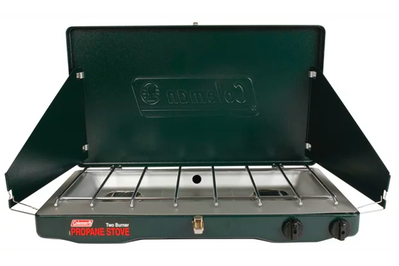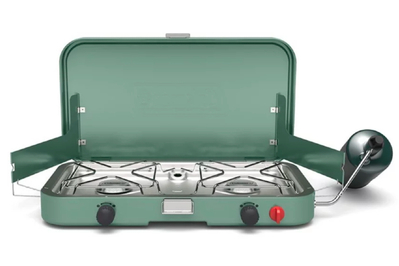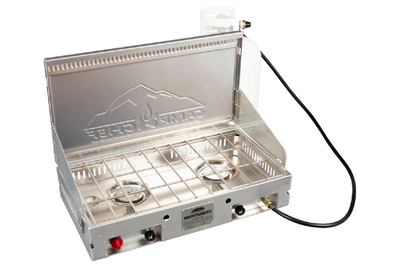Our pick
Coleman Classic Propane Camping Stove
This straightforward, rugged two-burner stove cooks food quickly and evenly. And it’s less than half the price of other stoves we tested.
Buying Options
*At the time of publishing, the price was $50.
The most important feature of the Coleman Classic Propane Camping Stove is its reliability—despite getting tossed in and out of our cars repeatedly, it continued to work perfectly. We also appreciated its versatility: This Coleman model boiled water faster than any other stove we tested under $150, yet when we turned it down low, it was gentle enough to griddle golden-brown pancakes. On a single 16-ounce tank of propane, this stove can cook with both burners on high for roughly an hour, and it has the barest minimum of parts, so it’s easy to maintain. This Coleman model does not have a piezo igniter (that little red button on a lot of stoves, including the our runner-up and upgrade picks, that lights the gas), so you’ll need to bring a lighter. To us, that’s just one fewer thing to break (and if you’re paying less than $150 for a stove, the piezo igniters almost always break).
Runner-up
Coleman Cascade 222 2-Burner Camping Stove
The Cascade is similar to the Classic stove, but it allows you to adjust cooking temperatures with more precision and includes a handle for easier carrying. However, it costs more.
Buying Options
*At the time of publishing, the price was $170.
If our top pick is out of stock or you’d like more cooking control (and potentially a touch more durability), the Coleman Cascade 222 2-Burner Camping Stove represents the next step up over the Coleman Classic. What separates it from the Classic (and adds to the price tag) is more control throughout the range of cooking temperatures. It boils water a bit faster than the Classic while still providing a gentle flame that lets you cook foods more delicately than on the Classic (for instance, if you prefer your eggs soft scrambled). It also includes a piezo ignition, which is fine as long as you don’t expect that component to last forever (none of them do). The Cascade case is easier to carry thanks to its included handle.
Upgrade pick
Camp Chef Mountaineer
Due to its solid construction, this two-burner stove is heavier to carry than the Coleman models and more expensive. But the Mountaineer also has a more-powerful output, so you can cook on it like it’s your home stove.
The heavy-gauge, all-aluminum Camp Chef Mountaineer is built like the tough, classic camping equipment you hear salty old-timers or vintage-equipment nerds talk about. It’s more expensive than either of our Coleman picks, but if you’re comfortable with the jump in cost, the Mountaineer may be worth the investment. Weighing just over 16 pounds, it’s 4 pounds heavier than the Coleman Classic. But with its large, three-way windscreen, a hookup for a big (5 to 20 pounds) propane bottle, and a 40,000 Btu output (double that of the Coleman Classic), the Mountaineer lets you do more in the way of high-heat cooking than our other picks. For instance, you can sear a steak at a higher heat than on our other picks for a darker char more quickly, which means you can cook more food in the same amount of time. Managing the controls does require finesse—with a stove this powerful, it’s easier to burn your food than to keep the heat low. This stove is great for the most committed car-camping gourmets, but for most campers, its cost and durability are overkill.
Also great
Original FireDisc Portable Propane Cooker
If you often cook for a crowd, the FireDisc’s paella-pan-like design is ideal for making big meals. This stove is great for those who don’t want to tote extra cookware.
Buying Options
*At the time of publishing, the price was $317.
Though you probably won’t be hauling the Original FireDisc Portable Propane Cooker far from your car (in total it weighs 55 pounds, the most of any stove we tested), it does break down into three fairly easy-to-carry components: two supporting trusses and one large pan. It has the simplicity and strength of something you’d expect to last a lifetime (with the proper care). In other words, the FireDisc should last a lot longer than its five-year limited warranty. It has a single-pan design (think of a wok or a paella pan, though the FireDisc is most closely related to a Mexican discada), so you can do away with the usual pots, pans, and sear plates. Cooking on the FireDisc is akin to using a large griddle plate: You can make a single large-pot meal, like a stew or fry-up, or set up zones for different foods, as you might when preparing fajitas. Either way, to some extent you’re inevitably cooking everything together, and the heat controls are limited.








